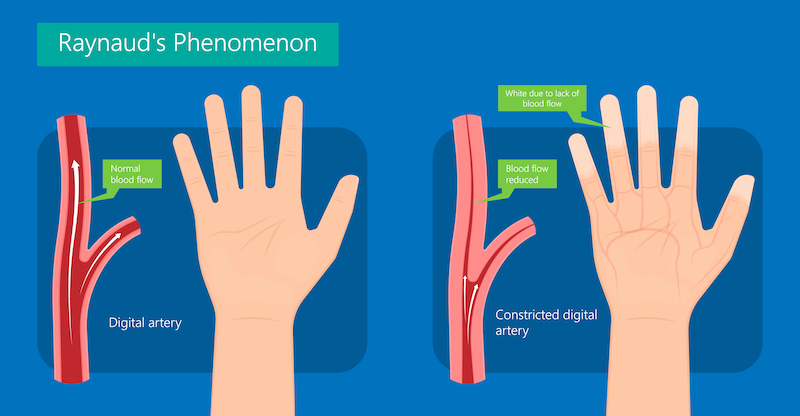WHAT IS RAYNAUD DISEASE?
AKA Raynaud phenomenon or Raynaud syndrome. There’s no cure for Raynaud disease, but you can manage it to help prevent attacks.
What triggers Raynaud disease?
→ Cold
→ Stress
→ Caffeine
→ Smoking
→ Repetitive movements
→ Certain medicines, such as beta-blockers, migraine medicine, birth control pills, and others
→ Injury
→ Emotions
WHAT ARE THE SYMPTOMS OF RAYNAUD DISEASE?
What happens during an attack?
A Raynaud disease attack is often triggered by cold or stress. During an attack, blood vessels suddenly narrow (called vasospasm). This most often happens in fingers and toes. In rare cases, the nose, ears, nipples, or even tongue are affected. Narrowed blood vessels reduce the blood supply to the area. The area then turns white, blue, or red. The area may feel tingling, numb, or painful. As the attack passes, the blood vessels open. The affected area may turn bright red as it warms up, then returns to normal color.
WHAT IS THE CAUSE OF RAYNAUD DISEASE?
With Raynaud disease, it’s believed that blood vessels in the affected areas respond too strongly to certain triggers, such as cold. This makes them narrow (called vasospasm) much more than in people without the disease. Experts don’t know what causes the blood vessels to react so strongly to certain triggers. In between attacks, the blood vessels are normal and healthy. Attacks don’t permanently damage the blood vessels. But they may thicken the artery walls.
In some cases, Raynaud disease happens along with another disease or condition. This is often a connective tissue disorder, such as lupus, scleroderma, or rheumatoid arthritis. This is called secondary Raynaud disease (as opposed to primary Raynaud disease discussed above) and may be more severe. If this is the case for you, you and your healthcare provider can discuss treatment for the underlying condition.
WHAT ARE THE RISK FACTORS?
→ Women are more likely to get Raynaud disease than men.
→ Younger people are at higher risk, usually ages 15 to 30.
→ Living in colder climates increases risk.
→ Having a family member with Raynaud disease increases your risk.
→ Underlying rheumatoid conditions may increase your risk.
HOW IS RAYNAUD DISEASE DIAGNOSED?
Your description of your symptoms, a health history, and a physical exam are often enough for a diagnosis. Blood tests and other tests may be done to see if any underlying conditions are present and rule out other problems.
HOW IS RAYNAUD DISEASE TREATED?
There is no known cure for Raynaud disease. But you can learn to manage symptoms and reduce the number and severity of attacks. For most people, avoiding triggers may be enough to limit attacks. Your healthcare provider may suggest the following:
→ Take safety steps to help prevent your hands and feet from losing circulation. This includes:
Dressing warmly in cold weather.
Wearing gloves or mittens when your hands may become cold, such as when you use the refrigerator or freezer.
Avoiding stress and caffeine.
Exercising regularly – this may reduce the number and severity of attacks.
If you smoke, quitting may improve the condition – smoking causes your blood vessels to narrow and reduces blood flow.
→ Soak your hands or feet in warm (not hot) water. Do this at the first sign of an attack. Keep soaking until your skin color returns to normal.

